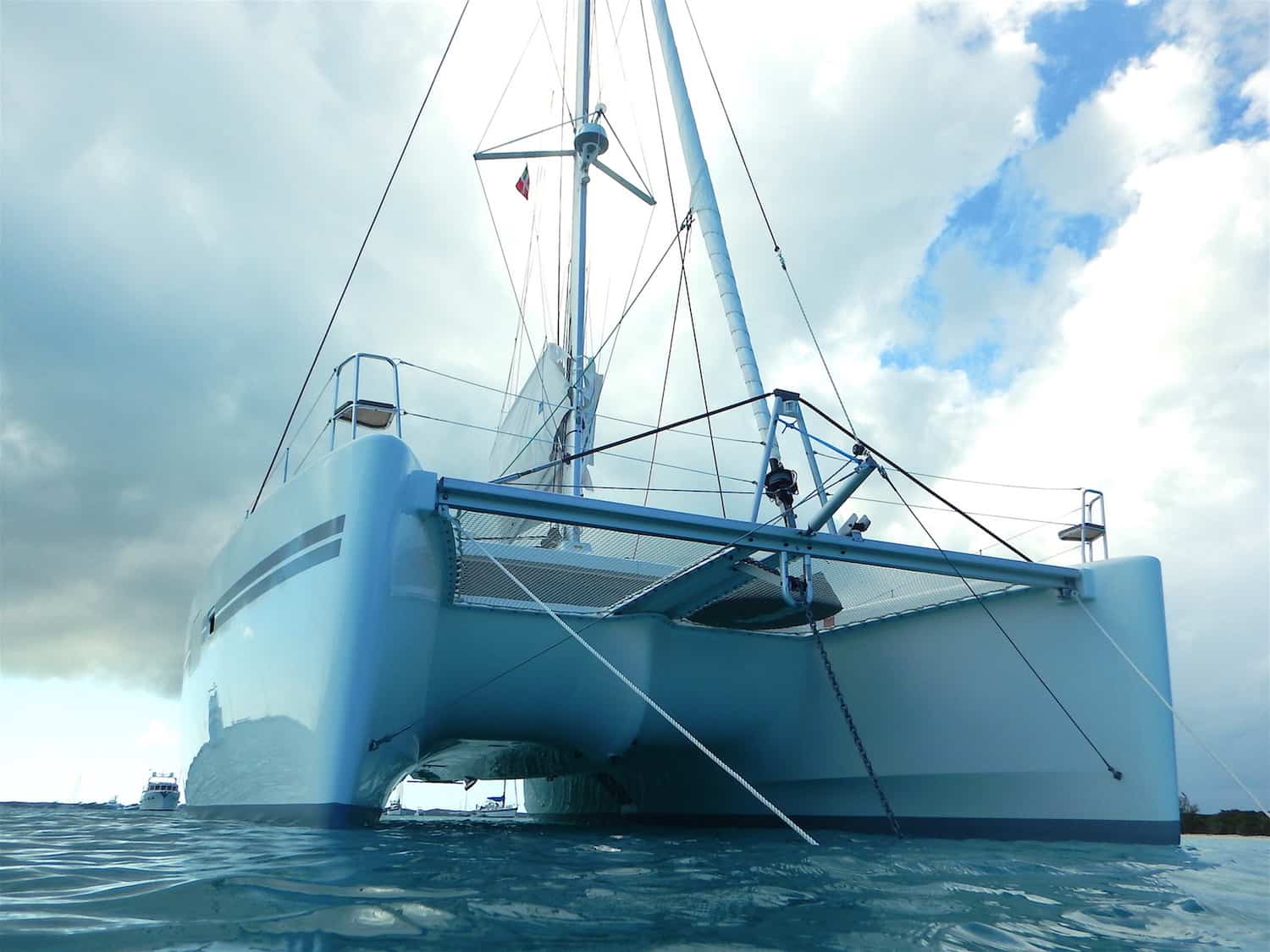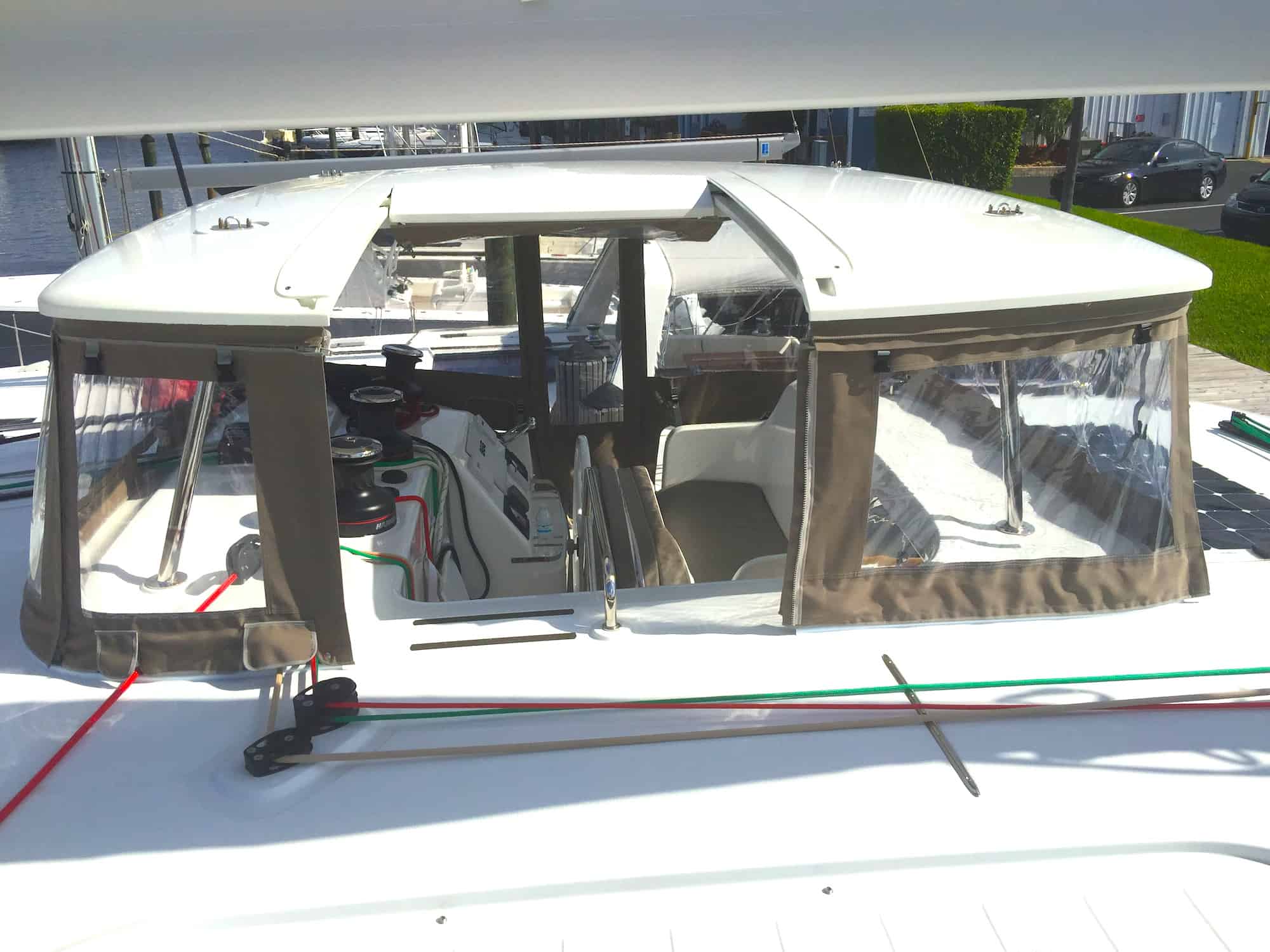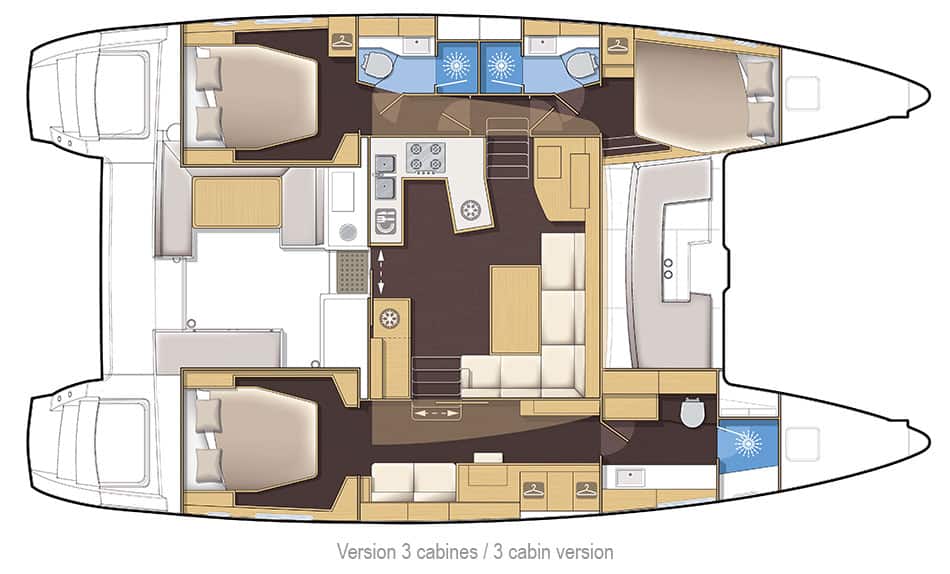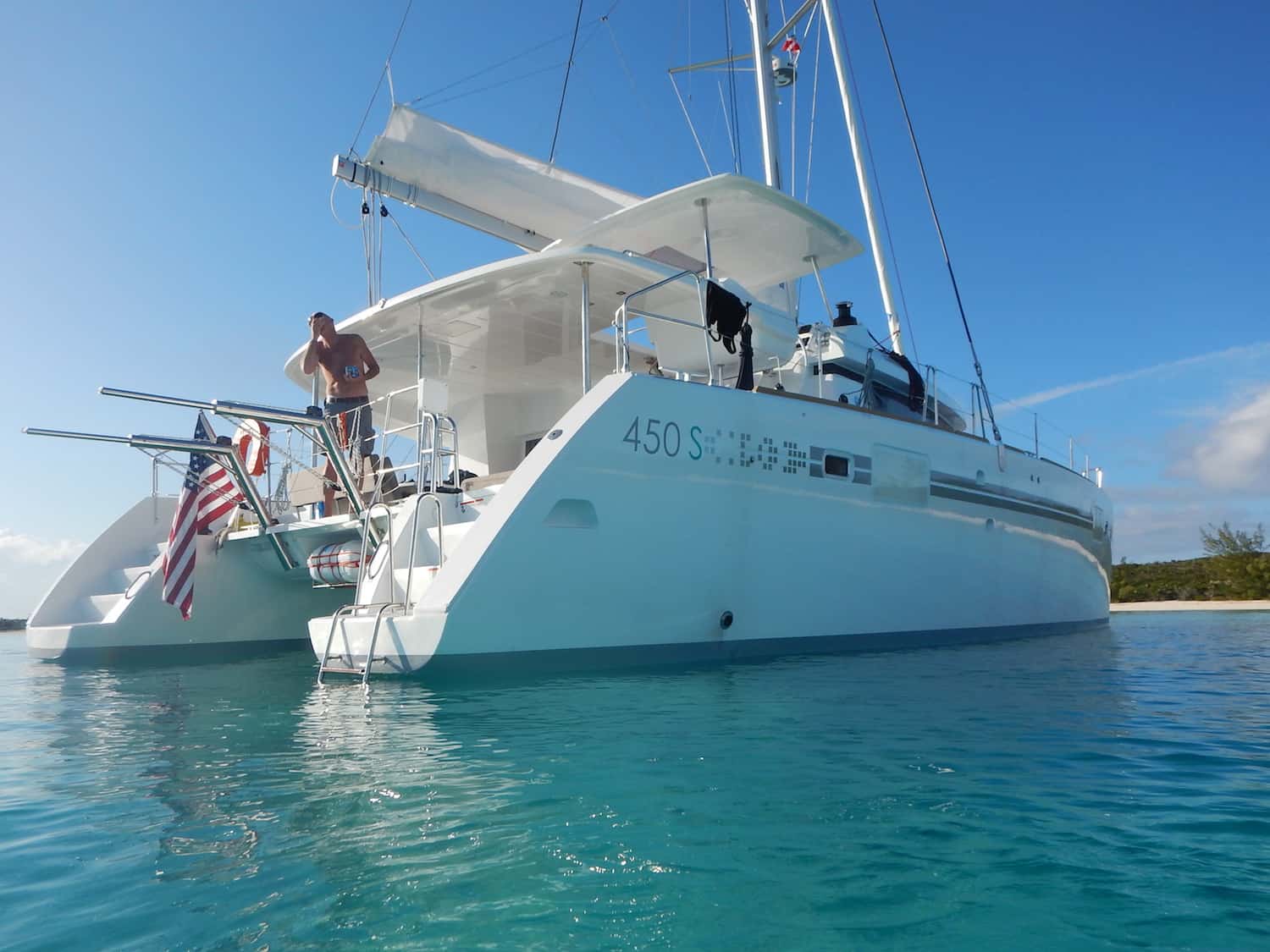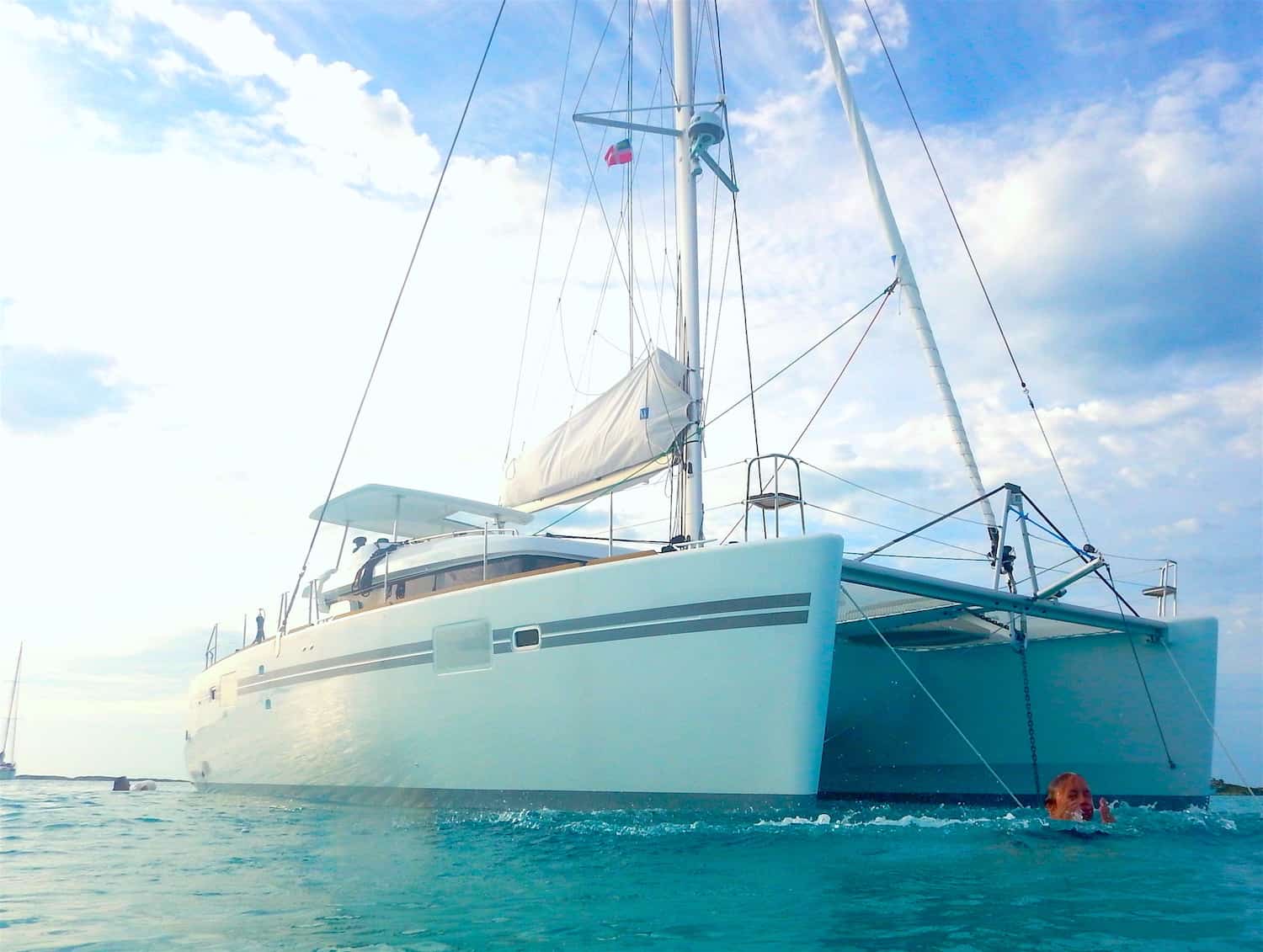Lagoon 450S Exterior, Design, Construction & Sailing Ability (Part 1)
In the last three months, we have completed 3 blue water sailing trips, totaling 2400+ NM, on our Lagoon 450S catamaran. We are ready to share our thoughts about its performance, as well as our likes and dislikes about the catamaran overall. When we first saw the drawings of the Lagoon 450S, we really liked the design. It had many of the features we wanted in a cruising catamaran, the most important feature being the semi-raised helm station. This was always a non-negotiable point for us and the SporTop fit the bill perfectly. The other catamaran choice offering a semi-raised helm would have been the Fountaine Pajot Helia 44 (review and pictures). The FP Helia is a nice boat, but we didn’t like the interior as much (purely personal preference) and it is substantially smaller than the Lagoon in volume (click on the picture below to see the comparison).
p
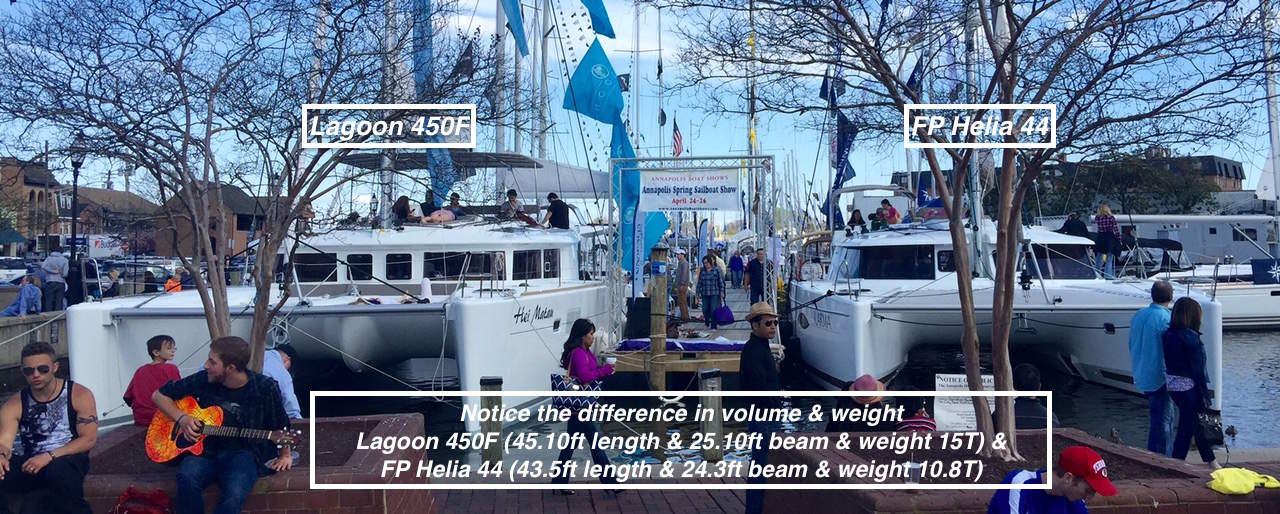
Good cruising performance was another important feature but since living space is equally important to us, we opted to go for a cruiser rather than a racer cruiser like Outremer or Catana. We live and work aboard and we occasionally do educational charters. Therefore, we wanted good interior space, but we certainly did not want a slug either.
Based on previous sailing reports and the Lagoon design team’s projections, the Lagoon 450S seemed the right choice for us (Read our post about “Why we chose the Lagoon 450S” ).
We originally weren’t too thrilled about owning one of around 500+ similar catamarans built in the last four or so years. On top of that, production boats like Lagoon and Fountaine Pajot are often times unfairly tagged as “condomarans” that cannot sail worth a damn. These perceptions were not a good start for our new “home” right off the bat and not great for our exit strategy either. So, we researched this extensively. We found that unlike some other brands, statistics proved that Lagoon’s resale is very strong, particularly the 3-cabin version. But the 4-cabin Lagoons don’t do badly either. So we made peace with that issue, knowing that Lagoon holds its value fairly well. Moreover, we figured that with so many units built, all or most kinks should be worked out on this model by now. We really liked that idea!
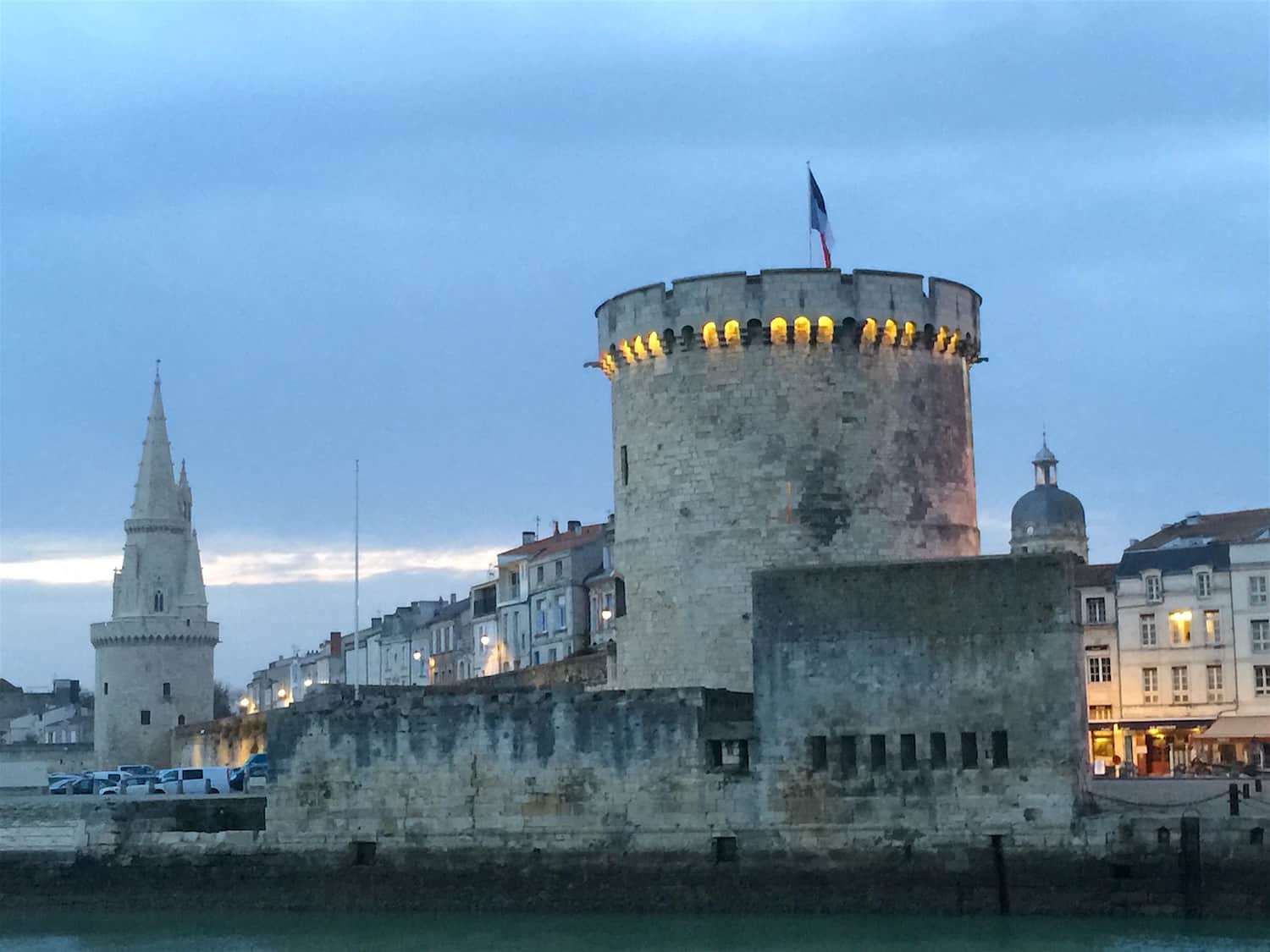 Lagoon’s other negative has always been the “bulky design” and because of that bulky build and straight-up windows, amongst other things, it has gained the reputation of being a “non-performer” amongst cruisers and other builders. Lagoon updated its designs over time and has produced some nice looking cats lately. The newer designs are much more elegant and, hard as we tried to find fault, this catamaran is a good, solid, well-crafted vessel. After doing a Lagoon factory tour in France, we were happy that the quality of this vessel is superb.
Lagoon’s other negative has always been the “bulky design” and because of that bulky build and straight-up windows, amongst other things, it has gained the reputation of being a “non-performer” amongst cruisers and other builders. Lagoon updated its designs over time and has produced some nice looking cats lately. The newer designs are much more elegant and, hard as we tried to find fault, this catamaran is a good, solid, well-crafted vessel. After doing a Lagoon factory tour in France, we were happy that the quality of this vessel is superb.
At the Lagoon factory, a quality controller oversees every stage of the production during the entire build process and every imperfection is dealt with immediately (see the video below in “construction” section). That was very impressive and set our minds at ease. We highly recommend doing a factory tour in La Rochelle. Not only is it very exciting to see your boat being manufactured, but the city of La Rochelle is a gourgeous old walled coastal city situated in the southwest part of France (AND the French food and wine is exquisite)! See a live cam of Port de Plaisance in LaRochelle, France.

How Did The Lagoon 450S Catamaran Measure Up?
So, on the surface we liked the Lagoon 450S. BUT, did it pass the test for our purposes as live-aboards with a penchant for sailing long ocean passages?
Lagoon 450S Sailing Ability 
As I said before, over 500 Lagoon 450 Flybridge versions were produced. So this model has already proven itself to be a good ocean cruiser in various ocean crossings and rallies like the ARC Rally. Bearing in mind that the 450S is not a performance catamaran, we were pleasantly surprised with her performance under all conditions. Period. Doing a 200+ NM sailing day is very important to us. We often sail long distances and we wanted to be able to make good progress every day and to out-run bad weather if possible. It was a goal that we easily achieved on our delivery from Guadeloupe and subsequently on other passages.
Lowered Boom: We really liked that the boom on the SporTop is substantially lower than the Flybridge version (28 inches), with a mast height of 74 ft. The lower boom brings the center of gravity down lower and reduces inertia in the rig. That, coupled with the increased bouyancy forward created by the chines on the inside of the bowsand the sail plan, increases performance and eliminates hobby horsing, making it a faster and much more stable and comfortable ride, despite the maximum volume and very high freeboard.
Nimble In Light Conditions: During our delivery from Guadeloupe the boat sailed very well on all points of sail and did well even in very light winds which was a pleasant surprise. She easily sails at 50% of apparent wind speed. Generally, most boats will sail well in strong winds, but it is the light wind performance that defines whether the boat is a good sailor or not and the 450S is very nimble in light conditions in part because of the enormous 872sqft of square-headed fully battened mainsail.
Good Performance: She also displayed good upwind ability on a close reach and tracked really well. On a reach and beam reach, the favorite point of sail for a cat, our Lagoon sails like a dream. We often sailed in double digits without too much trouble. As an example; we sailed 41NM in 4 hours in 18-20 knots between Turks and Caicos and Georgetown in the Exumas on a beam reach in 6-8ft seas with little or no slamming. That is an easy 10.25Knots per hour – not a rocket ship to be sure, but certainly very respectable.
Squally Conditions: During our trip in the Gulf-stream going north, we were caught in several squalls. Conditions were deplorable with 10-12ft waves and had wind speeds of up to 38 knots. We were able to luff up the main and reef down in no time, which was easily done from the safety of the cockpit. Luffing up is the best course of action when you’re temporarily overpowered. It reduces the speed and helps keep the boat under control. Once we had the reefs in, we bore away and ran with the wind. The boat was moving at around 12 knots with 38 knots of true wind from astern. By running or doing a very broad reach we managed to reduce the apparent wind speed on the rig to around a manageable 26 Knots until the squall blew through and we could resume our course. Video of our trip in the Gulf-stream
Genoa / Self-tacking jib: We have a full Genoa instead of a self-tacking jib. While the self-tacking jib is a nice feature for short-handed sailing, the sail is small for anything but a close or beam reach. Another reason why we opted for the conventional genoa setup, is that if a jib sheet parts, it is easy to use the lazy sheet to control the jib while replacing the damaged sheet. If the sheet parts on a self-tacking jib, which has only one sheet, there are all sorts of problems and you have no choice but to furl the sail if you can.
Speed: Would it be nice to sail faster? Sure, but the thing is, when you start sailing in the high double digits like say, a Gunboat, you have to pay close attention.&Remember, on cats you don’t much “feel” the performance. It does not heel but rather accelerates and this is where it becomes tricky. If you don’t spill the wind on the main, you can easily break something. One evening, with an unexpected gust of wind, we surfed down a huge wave at 18.3 knots. We did not even feel it coming until the boat suddenly accelerated like a sports car! Add very strong sustained winds to that and things can get tricky.
Sailing upwind: It is commonly believed that a catamaran cannot point as high as a monohull unless it has daggerboards. That is not exactly accurate. Generally most catamarans point as high as cruising monohulls but make more leeway because they have less lateral resistance although, catamarans with daggerboards do point higher than ones with fixed keels. However, if you fall off the wind 5 – 10 degrees, its boat speed will be higher than an equivalent monohull and maintain a faster VMG upwind. In fact, Dennis Connor’s 1988 America’s Cup victory on ‘Stars and Stripes’ in San Diego over KZ-1, the world’s most radical 90ft. monohulls, bears this out.
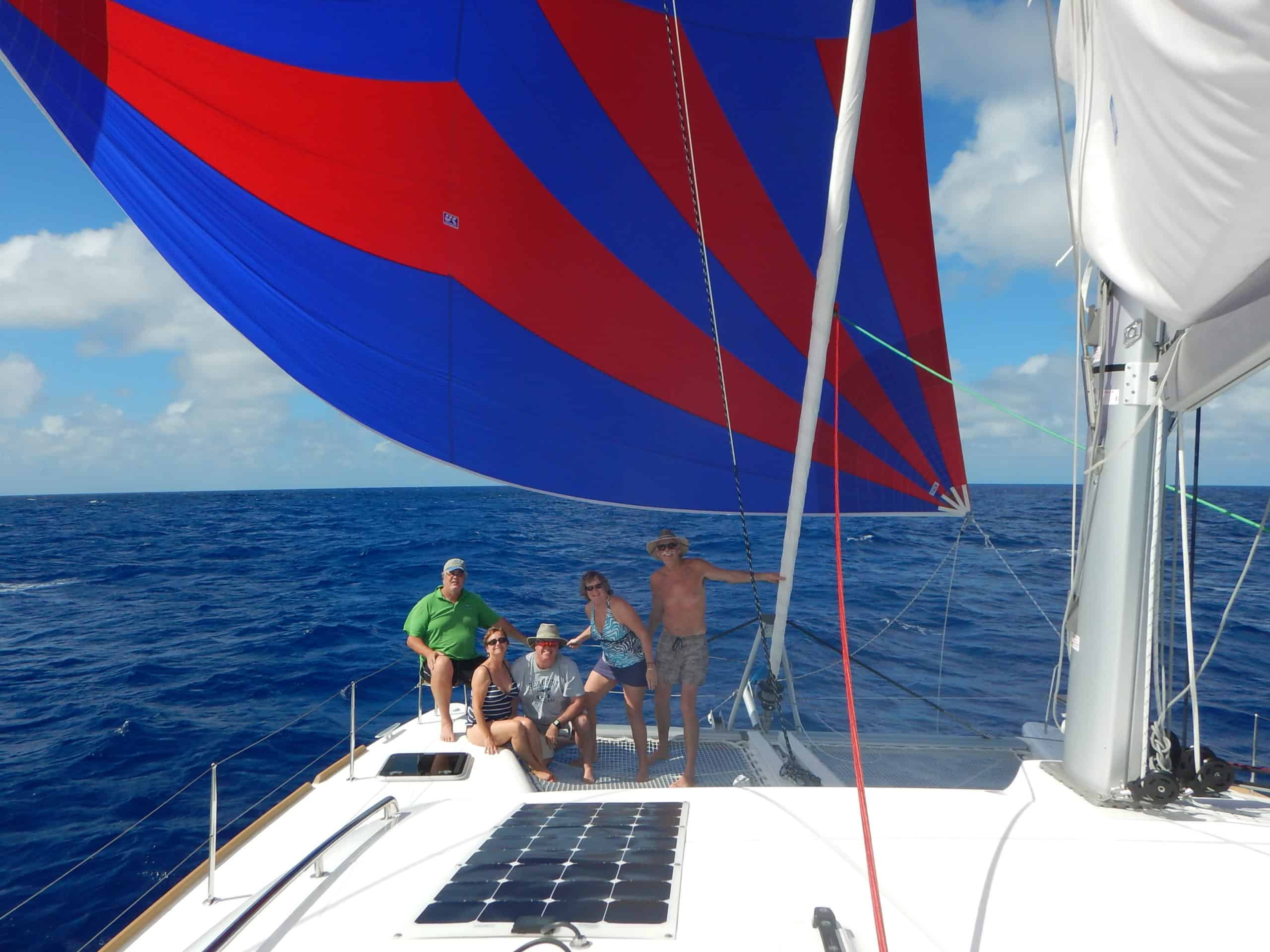
Sail changes: Stephen and I did several sail changes on delivery, including hoisting the spinnaker. It was easy enough to do. All the lines come back to the cockpit and quite frankly, even as big as this rig is, it was not very difficult to handle the sail changes single handedly. The single line reefing makes it really easy to reef quickly. We learned how easy it was to reef at two o’clock in the morning when a massive squall hit us out of nowhere while sailing north in the Gulf-stream from The Abacos in the Bahamas to Norfolk.
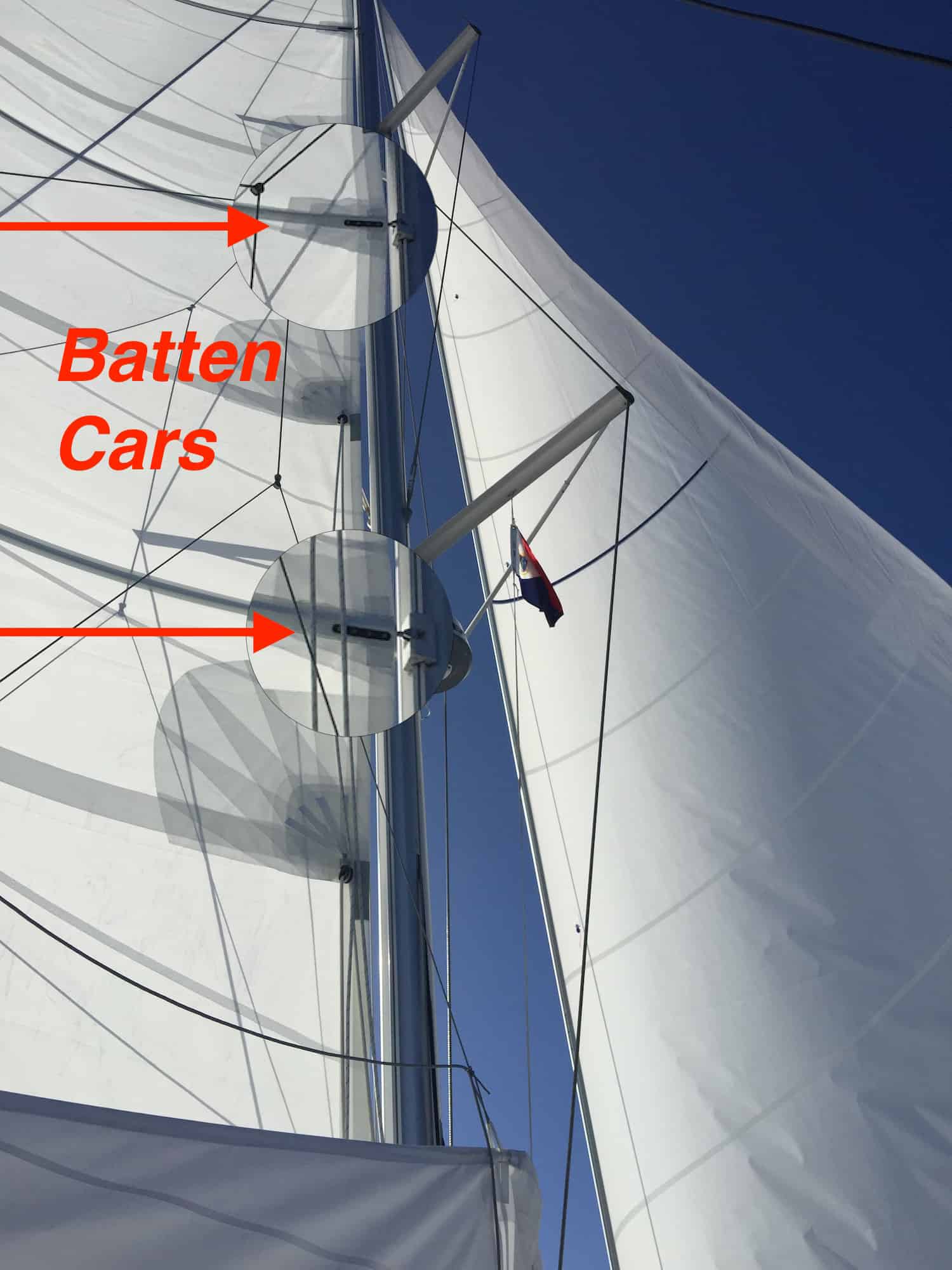 Asymmetrical Spinnaker: We opted for the “Asymmetrical Spinnaker Gear” which includes two winches aft. We bought two secondhand spinnakers for very little, instead of US$7,000+ for a new Asymmetrical sail and they worked great! Cruising multihull sailors favor asymmetrical spinnakers for downwind sailing in light winds. The dousing sock makes deployment and dousing easy.
Asymmetrical Spinnaker: We opted for the “Asymmetrical Spinnaker Gear” which includes two winches aft. We bought two secondhand spinnakers for very little, instead of US$7,000+ for a new Asymmetrical sail and they worked great! Cruising multihull sailors favor asymmetrical spinnakers for downwind sailing in light winds. The dousing sock makes deployment and dousing easy.
We have a pad eye on each bow and attach the tack of the sail to the windward bow using a snatch block and a line back to the forward cleat (the reason for this is that if you get into a situation it is easy to release the cleat line and let the tack fly free, you can then recover the sail using the sheet by pulling it down behind the main).
The head is hoisted using the spinnaker halyard and the clew is attached to a sheet that runs outside of everything to a block on the leeward side stern and then to a winch for trim control. To get the best performance out of the Asymmetrical, you should ease the sheet until the luff of the sail starts to collapse and then sheet in a bit. Ideally you should see a periodic flapping/collapsing of the leading edge of the sail but only about a foot or so. Be mindful not to sail with the Asymmetrical sheeted in too tight; it will not perform to its optimum.
To conclude, we have few complaints about the sailing ability of the Lagoon 450S!
Sailing Ability
The mainsail is a little sluggish in coming down. Intermediate cars would have made all the difference. The distance between the cars on the sail is around 10-12 feet. When the sail drops, having this much distance between the cars, makes the sail billow out and prevents the sail from coming down fast. It’s an easy fix though.
Sailing Ability: What The Experts Say 
« 19 days! Maybe not a “Route du Rhum” time, but nevertheless a very creditable performance for a voyage from La Rochelle to Pointe à Pitre (3477 miles) in a strictly standard Lagoon 450.” »Jean-François Tanguy, professional skipper – February 2011
« The 450 rewarded us with pleasant, lively behaviour in the light to moderate conditions; it jogged along with a spring in its step… » Phillippe Echelle, Multihulls World 2011
« The sailplan gives the boat enough power to remain fast and dynamic in a wind of less than 10 knots. » Multicoques magazine, FR / Multihulls World, UK-January 2011
Construction 
This boat is well constructed. Even as we pushed the boat with as much power as the conditions allowed, we did not notice excessive creaking or shuddering. We had some VERY picky crew members on board. They inspected every corner of the boat but could not find much fault. Every inch of the boat is well finished, even in the darkest corners. When we did the factory tour, we noticed that every stage of the build was inspected for quality along the way, and you can tell from looking at the finished product.
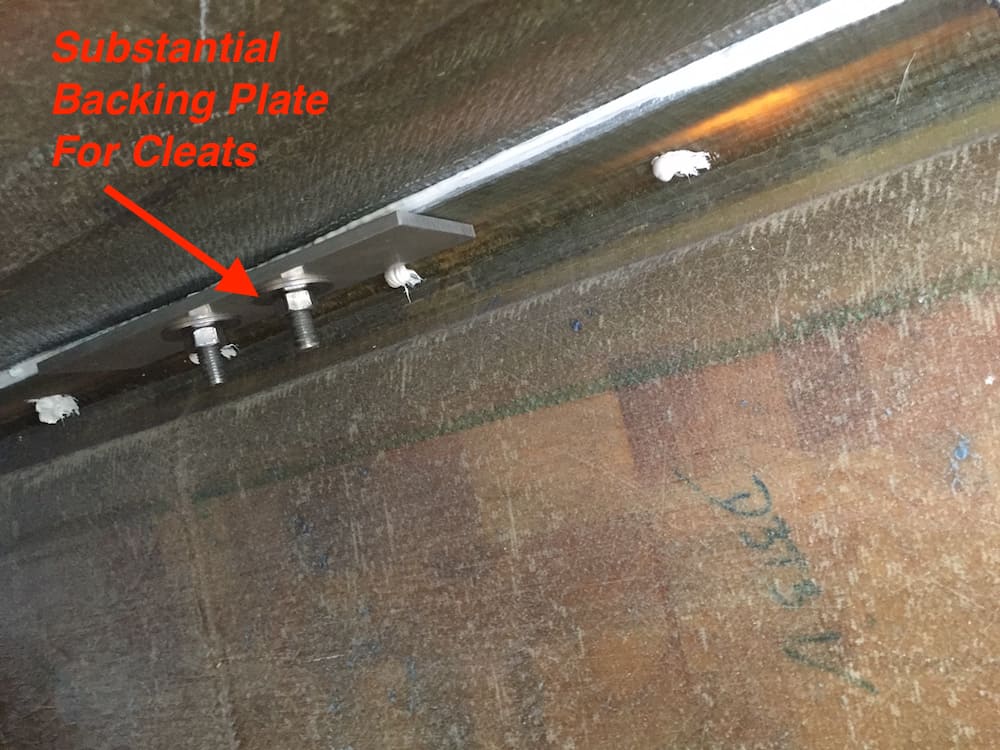 Small details: Lagoon has really paid attention to some of the things that only cruisers will notice, i.e., the deck is just slightly slanted towards the gunnels so that water will run off the decks into a little gutter and run out the back. There is therefor no pooling of water anywhere on the deck, something that is almost always a problem on cats. There are also little gutters right around all the hatches which are recessed and into the gutter on the sides of the deck, to create flush decks (no toe stubbers).
Small details: Lagoon has really paid attention to some of the things that only cruisers will notice, i.e., the deck is just slightly slanted towards the gunnels so that water will run off the decks into a little gutter and run out the back. There is therefor no pooling of water anywhere on the deck, something that is almost always a problem on cats. There are also little gutters right around all the hatches which are recessed and into the gutter on the sides of the deck, to create flush decks (no toe stubbers).
Every surface on the deck is flat and even, with no unnecessary steps up or down, a great safety feature in our opinion. There are steps molded in the side of the hulls picture that makes boarding easy, even with a high freeboard like this Lagoon. The gates are situated right at the shrouds above the steps, which allows for good handholds when boarding and in fact, there are sturdy handholds all over the boat, a big deal for safety at sea. We have often seen these things not line up on cats, making it hard to board.
Vacuum Infusion: What impressed Stephen (the more technical member of our team) is that the hulls are vacuum infused, ensuring the optimum laminate/resin ratio which reduces weight significantly. As we know, weight is a killer for catamarans and less weight allows for more volume; Good or bad, I don’t know. But what I do know, is that in spite of the much talked about heavy “condomarans”, this boat sailed very well and is comfortable in all conditions.
Solid construction: The other things that made an impression on Stephen is that the rudder tube is composite and laminated into a solid section of the hull towards the stern instead of on the join (which would have been the easy thing to do). The chain plates are well bedded onto a section of very heavy duty solid laminate which transfers the load into the hull section. All equipment fitted on the deck, such as the cleats, have substantial backing plates for strength (see the picture insert). That is however not the case with all catamaran brands. We have heard of cleats being ripped out of the deck on some cats in strong winds.
The main vertical bulkhead runs from one side of the deck to the other. The mast is stepped on this bulkhead to distribute 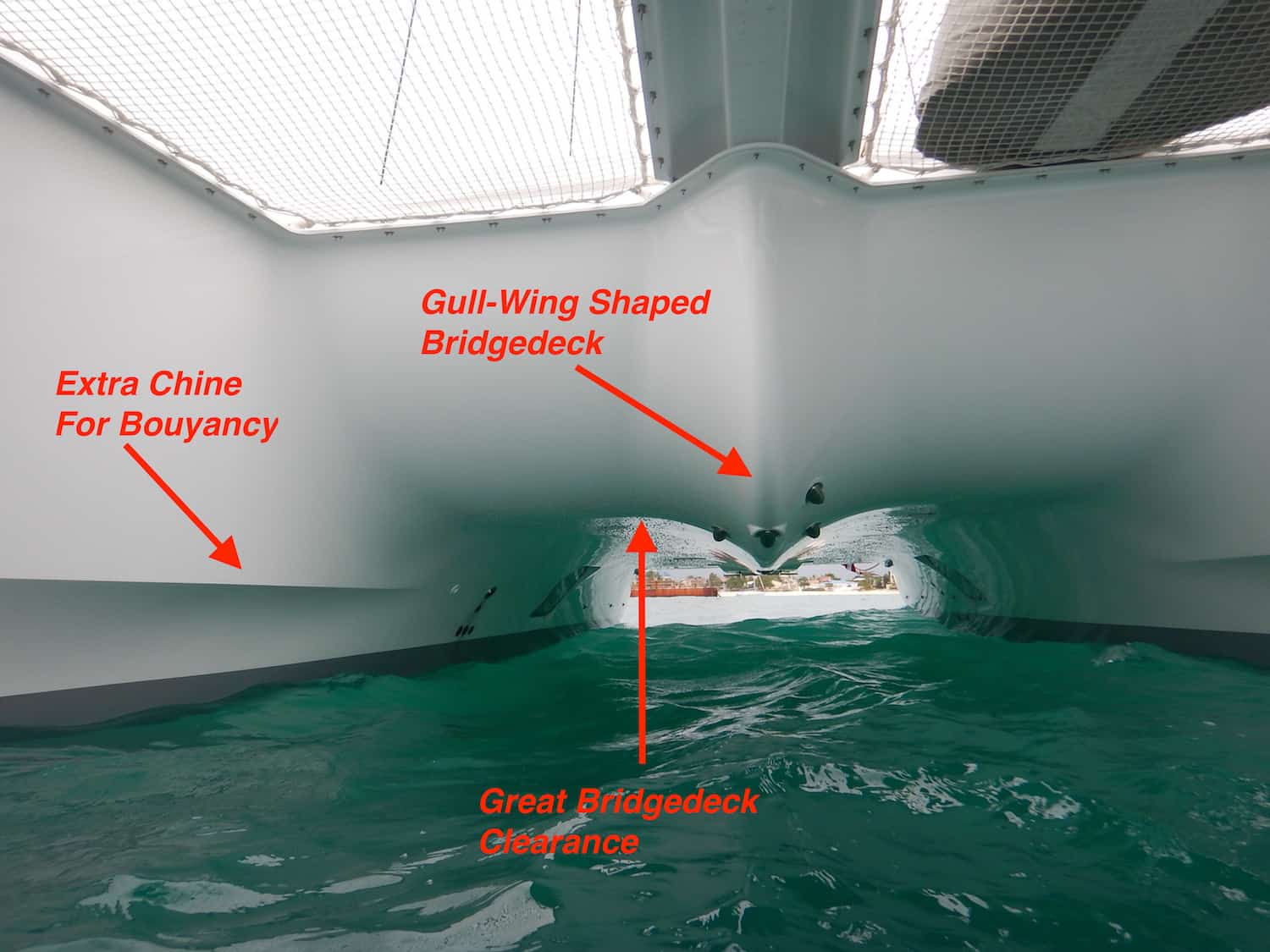
the down force of the mast step across the full beam of the vessel. This is why we saw virtually no flexing and the leeward shrouds remained tight even when there was considerable pressure on the rig when reaching. There are absolutely no stress cracks anywhere on the hull, something that we experienced on some other catamarans.
Bridgedeck Clearance 
The bridgedeck clearance is around 26 inches, which represents 5% of LWL, which is a very respectable ratio. (Read here about bridgedeck clearance on catamarans). One of the biggest surprises for us was how quiet the boat was during passages. There was very little slamming even in big steep seas. Now, we all know that catamarans slam under the bridgedeck from time to time. There is no getting away from it but it’s the degree of slamming that makes the difference.
We have been in catamarans where the saloon table literally bounced up and down and the whole boat vibrated from the slamming on the bridgedeck. The Lagoon 450S’s bridgedeck clearance is very good and the transons are well out of the water even fully loaded. The gull-wing shaped tunnel breaks the waves somewhat, which reduces wave impact and therefor slamming. It really is a feature that we were very pleased about since it is crucial for catamaran seaworthiness and crew comfort.
The Semi-Raised Helm Station 
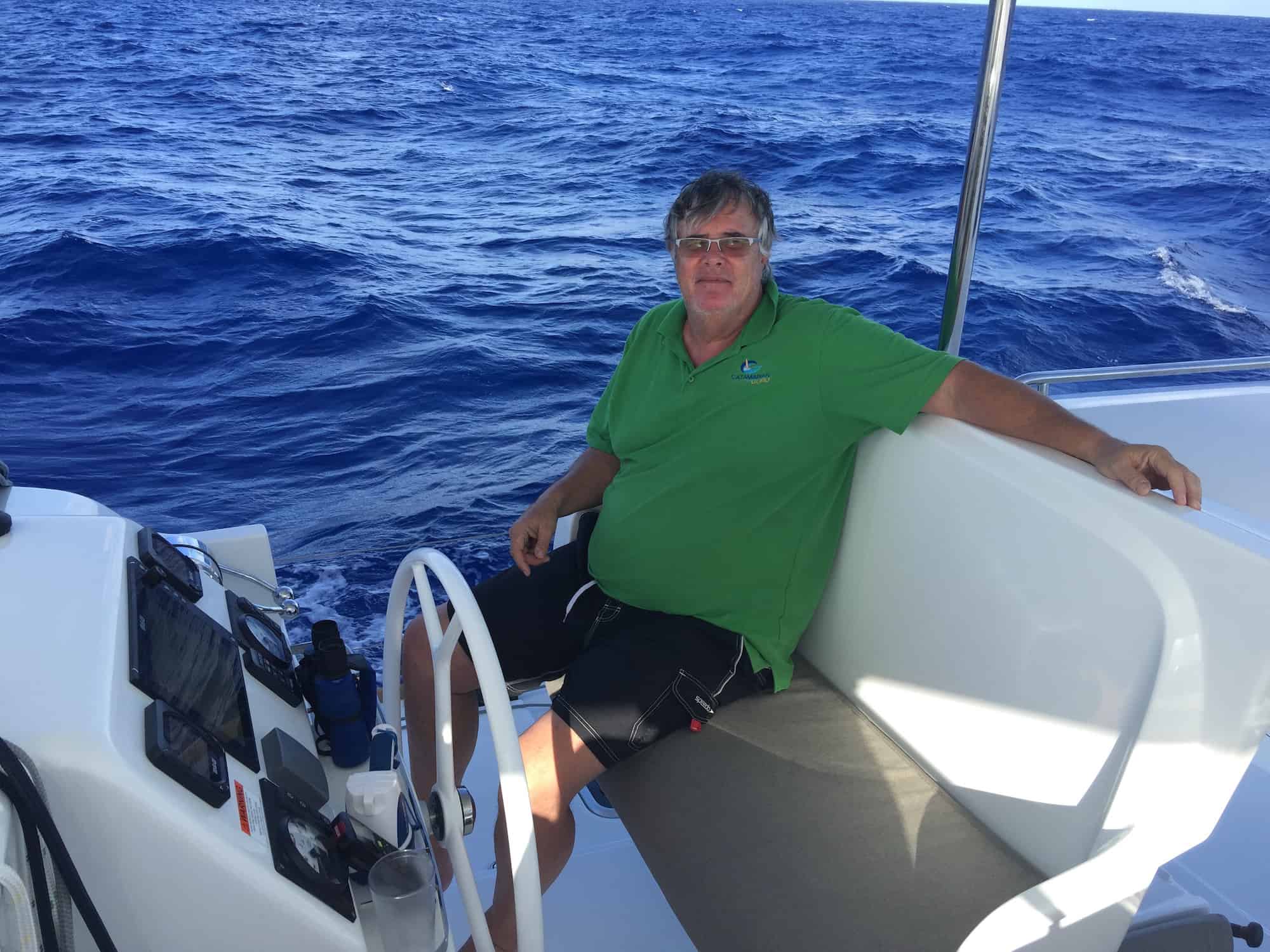 The helm station is one of the biggest reasons we went with this Lagoon model. The semi-raised helm station is designed to integrate with the whole design of the boat and is pleasing to the eye. It is well laid out, comfortable, safe and big enough for two or three people. One has good accessibility to both the cockpit and coachroof from the helm with sturdy, solid stairs from the cockpit to the helm and up to the coachroof. The helm station also has plenty of handholds and places to wedge oneself to work the winches.
The helm station is one of the biggest reasons we went with this Lagoon model. The semi-raised helm station is designed to integrate with the whole design of the boat and is pleasing to the eye. It is well laid out, comfortable, safe and big enough for two or three people. One has good accessibility to both the cockpit and coachroof from the helm with sturdy, solid stairs from the cockpit to the helm and up to the coachroof. The helm station also has plenty of handholds and places to wedge oneself to work the winches.
Safety: The person on watch in the cockpit can still be social with other crew down in he cockpit or even in the galley. When it’s just the two of us on long passages, ease of social interaction and safety concerns makes a big difference for peace of mind. We are always within easy reach of each other.
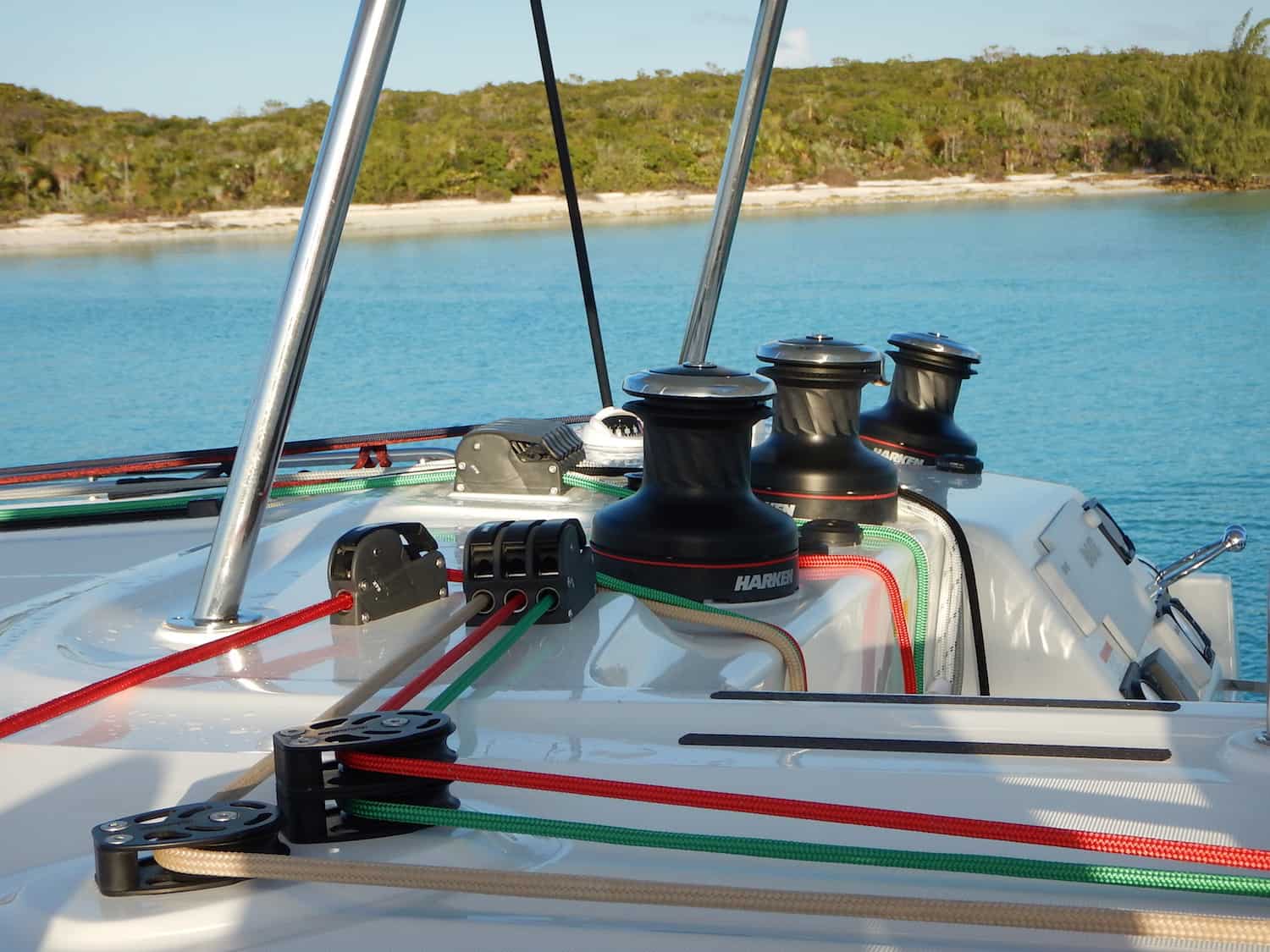 Hardtop bimini: The hardtop bimini over the helm is fitted with a slider which, when opened, makes it easy to see the trailing end of the sails but keeps the weather out when necessary. The rope clutches/
Hardtop bimini: The hardtop bimini over the helm is fitted with a slider which, when opened, makes it easy to see the trailing end of the sails but keeps the weather out when necessary. The rope clutches/ 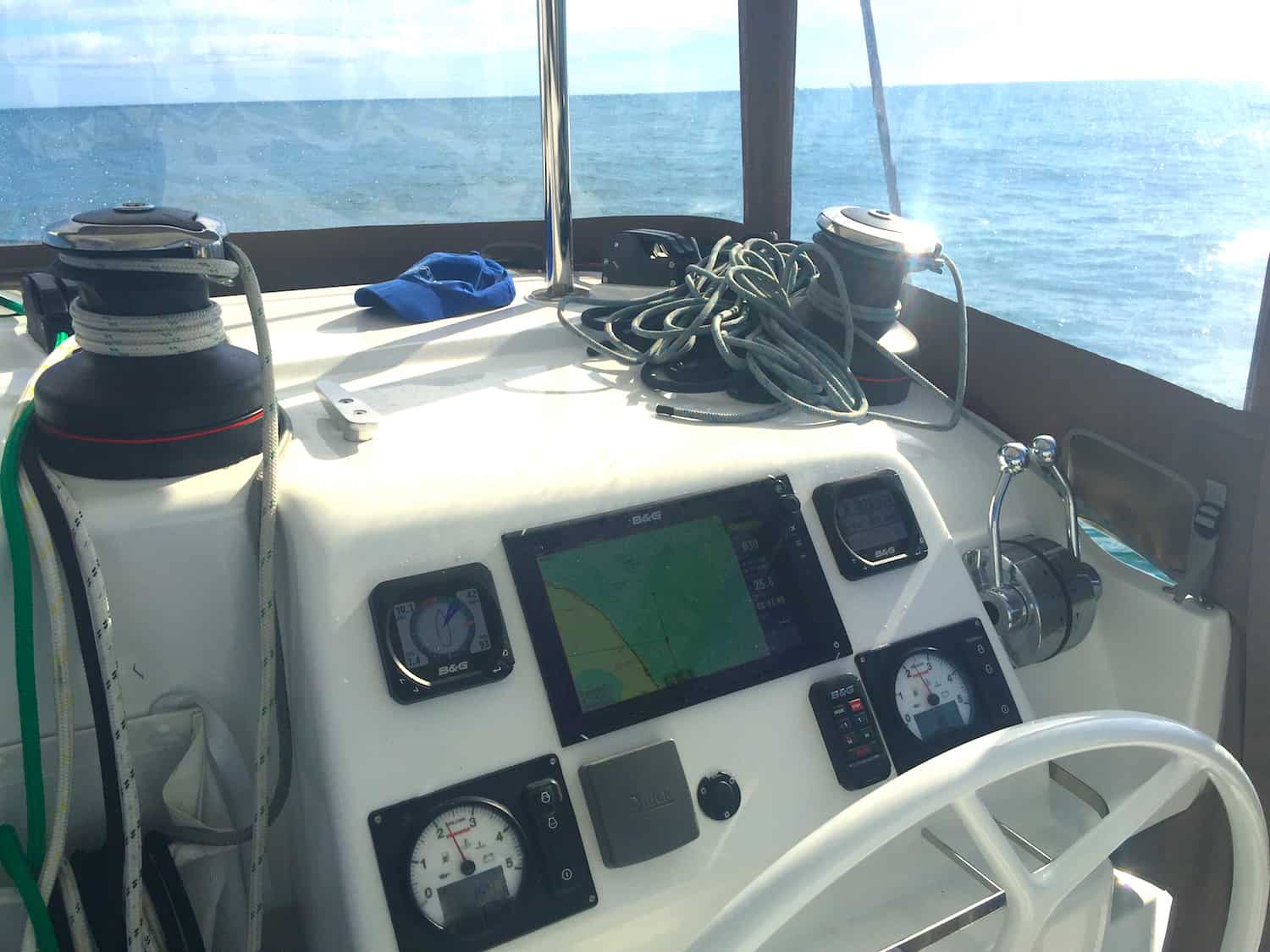 jammers and Harken winches (all electric), are well positioned and even though all the lines in the cockpit could be intimidating, they are all well marked and have rope bags and a rope locker to tidy up with. The halyards however, need a good place, which we have not figured out yet.
jammers and Harken winches (all electric), are well positioned and even though all the lines in the cockpit could be intimidating, they are all well marked and have rope bags and a rope locker to tidy up with. The halyards however, need a good place, which we have not figured out yet.
Instrument panel: The instrument panel is awesome! There is a lot of space for instruments on the instrument panel. The engine panels are
well positioned on the panel, so you don’t have to bend down to see the engine RPMs. One has good visibility of the sails and all four corners of the catamaran and the engine controls are in a good position even for a shorter person.
Bimini Enclosure: We had a hardtop bimini fitted over the helm (option) with a full enclosure. The factory did a great job with that enclosure! It’s well made and completely encloses the helm, which was a godsend in some of the weather we had sailed in. Video The B&G Electronics is new to us but we like it. It’s touch screen with lots of features; we are still learning! Our plotter has its own wifi  network and connects to our I-phones and iPad. The AIS (Automatic Identification System) is great at night, particularly in bad weather for spotting and tracking other vessels.
network and connects to our I-phones and iPad. The AIS (Automatic Identification System) is great at night, particularly in bad weather for spotting and tracking other vessels.
The Semi-Raised Helm Station 
The one negative is that I (Estelle) am a little short to stand and see over the coachroof properly, but I have found a vantage point that works for me.
|
TECHNICAL SPECIFICATIONS
|
Anchor 
The anchor locker is deep and wide, which stops chain from piling up and jamming the windlass. It comes with 170ft of oversized 1/2inch chain (a little overkill but it is great for sleeping soundly at night). The boat easily carries the weight. it’s stowed right in the chest under the mast and we have plenty of buoyancy up forward. We did replace the anchor with a 74-pound Rocna anchor. We keep the other one as our secondary anchor. It would have been nice to have a second bow roller to leave the second anchor in place but because of the way the anchor is situated in the chest, it is not possible.
Electrical & Plumbing 
The electrical panel is adequate and user-friendly. The system is well protected with breakers at every critical juncture. It has easy access to all wire and technical spaces. Access
to the circuit breakers (general and engine) is easy and protected in a housing with a hinged cover at the foot of the berth in the aft cabin. The plumbing is easily accessible everywhere and everything is high quality.
Electrical & Plumbing 
Two of the breakers are in very awkward spaces and were hard to find at first.
Engine Power & Generator 
We chose to upgrade to the 57 HP Yanmar engines with Flexofold props and we’re glad we did. They give us lots of power when we need it. The engine rooms are accessed from the scoops and have a lot of space. There is plenty of space inside the compartment to be able to work on an engine with ease if necessary. There is also a convenient storage shelf over the engine compartment. We use three big storage bins so it’s easy to unpack if necessary. The Cummins 13KW generator in the chest of the boat has great access and is remarkably quiet.
Engine Power & Generator 
We replaced the manufacturer’s fuel filter units fitted by the factory with two Racor 500’s. The manufacturer’s units were just too complicated. Stephen likes to be able to change the Racor filter cartridges quickly in the event of a blocked filter and the Racor filters, which he knows well, do the job best. Under engine we do a comfortable 7.5 knots at 2,500 rpm & 8.9 at 3,200; both cruising speed and top speed are satisfactory.
Scoops / Aft Boarding Steps 
The steps in the “scoops” are a little steep and the bottom step is not deep enough. This is a big negative for fishermen!! On our Island Spirit the scoops were huge, wide and shallow. It’s a great place to land the fish and then immediately cut up and clean it. Because of the size of the scoops, it is safe and has plenty of space to work even in big sea. Not so on the Lagoon 450S. We will probably rig a fishing table on the stern. Even so, the steps are easy to board from a dinghy and providea nice swim platform. On the positive side the high steps and angle are great to reduce noise when underway which, believe it or not is quite loud. The other advantage of the scoops on the L450 is that when you have big seas from astern the boat remains dry and it is very unlikely that you will be pooped.
Dinghy Davits 
They are sturdy and easy to operate. They are rated at 450-pounds per side and easily accommodate our Walkerbay 12ft deluxe super tender and Honda 20HP outboard engine. We had our dinghy and the engine hauled up and secured during passages and even with big seas the dinghy stayed steady and in place. The dinghy is fitted with a bridle and is easy to hoist. We have an electric winch right at the base of the davits and is easy to handle.
Trampoline 
I personally do not like the trampolines. They are uncomfortable and too “springy”. I never felt like we had a good footing when we went forward to change the sails while underway. Our last boat had a 60% closed netting system which was much more stable and comfortable.
Boat Owner Manuals
The owner manuals are fantastic. It is very precise with pictures to show the various systems, plumbing, electrics, etc., both in English and in French. The English version is not a “direct” translation from French, so you don’t have to guess what they are trying to convey. Each individual piece of equipment on board has a user manual and separate warranties.
Conclusion
Overall, we are very satisfied with our choice of catamaran. We fitted a rub rail with stainless insert, a satellite TV, Iridium, and some other equipment after market. But we pretty much had a finished boat when we accepted delivery. In general, the quality of the important equipment from the factory is good and you can see that this is a fully evolved product. All warranty issues (we only had a couple of things) were dealt with promptly. If we were building the boat ourselves, it would be tough to do much better. This Lagoon 450S is a really good, comfortable live-aboard blue-water cruiser. Our biggest pleasant surprise is her sailing ability and comfort at sea.
>>Part Two of the Lagoon 450S Review: Interior Living Space and Forward and Aft Cockpits!

